This pub is closed permanently. Your nearest Wetherspoon pub: J.J. Moon's
This was previously the long-standing Buck’s Head, becoming a Wetherspoon pub in 1990. ‘The white lion’ originally featured in the coat of arms of the Mortimer family and was later incorporated into King Edward VI’s coat of arms, who inherited the white lion from his grandmother, Anne Mortimer.
Photographs and text about London Road.
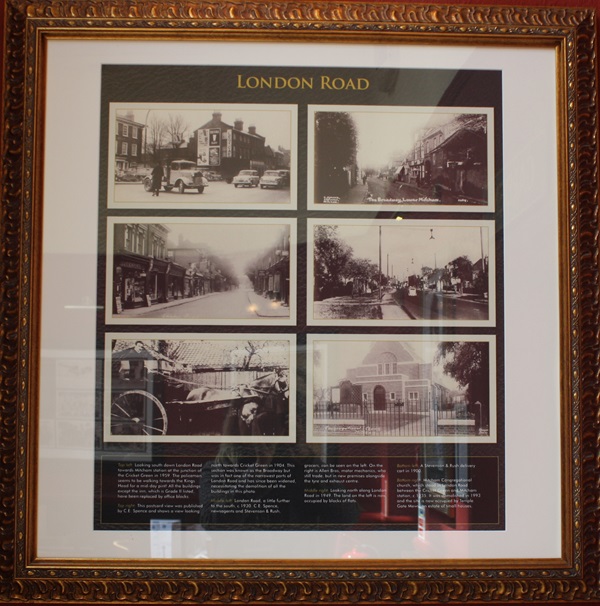
The text reads: Top left: Looking south down London Road towards Mitcham station at the junction of the Cricket Green in 1959. The policeman seems to be walking towards the Kings Head for a mid-day pint! All the buildings except the inn, which is Grade II listed, have been replaced by office blocks.
Top right: This postcard view was published by CE Spence and shows a view looking north towards Cricket Green in 1904. This section was known as the Broadway but was in fact one of the narrowest parts of the London Road and has since been widened, necessitating the demolition of all the buildings in this photo.
Middle left: London Road, a little further to the south c1930 CE Spence, newsagents and Stevenson & Rush grocers, can be seen on the left. On the right is Allen Bros. motor mechanics, who still trade, but in new premises alongside the tyre and exhaust centre.
Middle right: Looking north along London Road in 1949. The land on the left is now occupied by blocks of flats.
Bottom left: A Stevenson & Rush delivery cart in 1900.
Bottom right: Mitcham Congregational church, which stood in London Road between the Cricket Green and Mitcham station, c1935. It was demolished in 1993 and the site is now occupied by Temple Gate Mews, an estate of small houses.
Photographs and text about London Road.
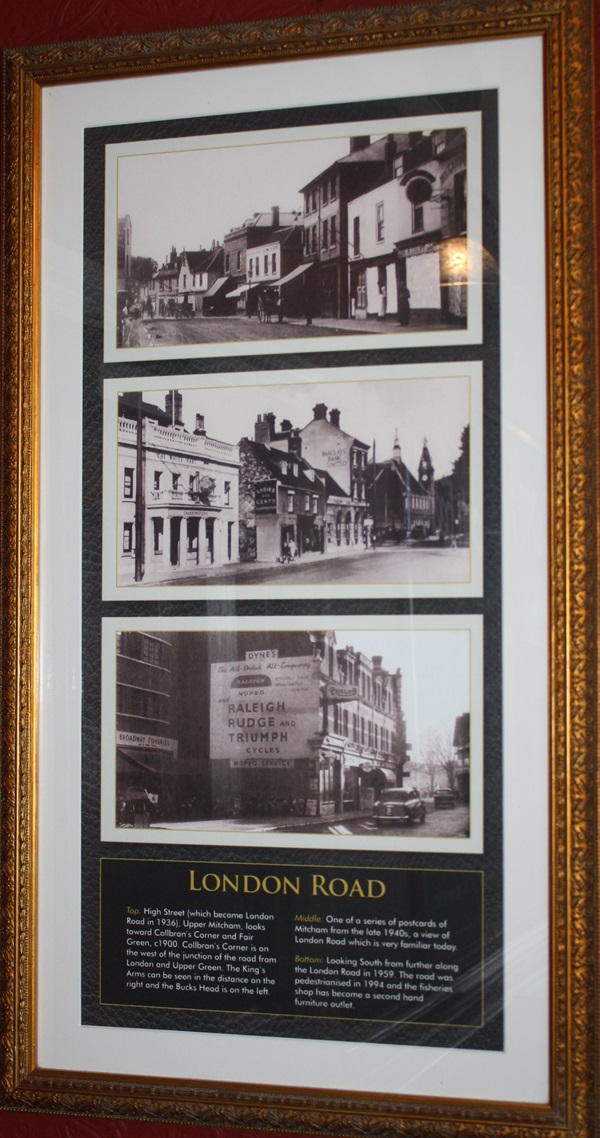
The text reads: Top: High Street (which became London Road in 1936), Upper Mitcham, looks toward Collbran’s Corner is on the west of the junction of the road from London and Upper Green. The King’s Arms can be seen in the distance on the right and the Bucks Head is on the left.
Middle: One of a series of postcards of Mitcham from the late 1940s, a view of London Road which is very familiar today.
Bottom: Looking South from further along the London Road in 1959. The road was pedestrianised in 1994 and the fisheries shop has become a second hand furniture outlet.
A photograph and text the South Londoner.
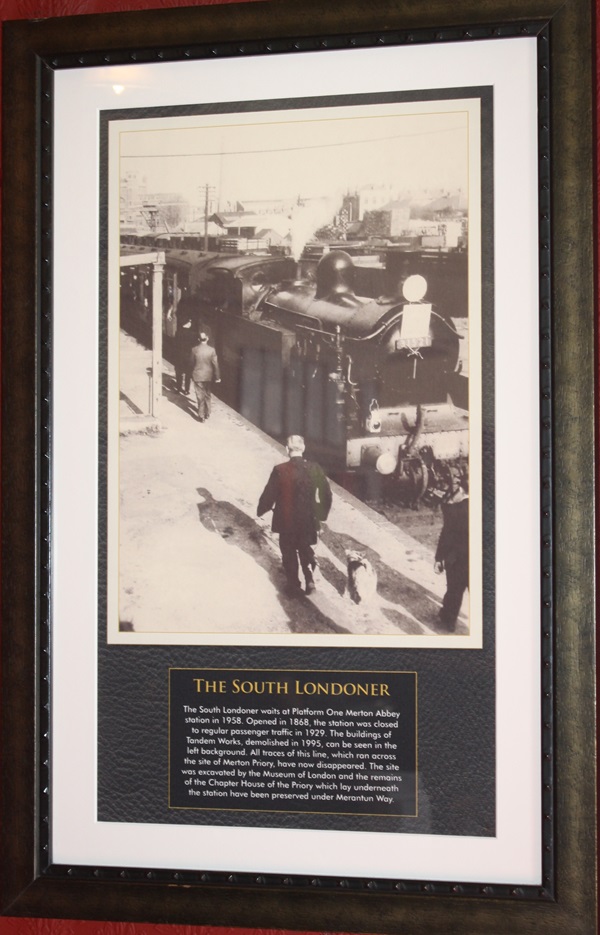
The text reads: The South Londoner waits at Platform One Merton Abbey station in 1958. Opened in 1868, the station was closed to regular passenger traffic in 1929. The buildings of Tandem Works, demolished in 1995, can be seen in the left background. All traces of this line, which ran across the site of Merton Priory, have now disappeared. The site was excavated by the Museum of London and the remains of the Chapter House of the Priory which lay underneath the station have been preserved under Merantun Way.
A photograph and text about Hall & Co.
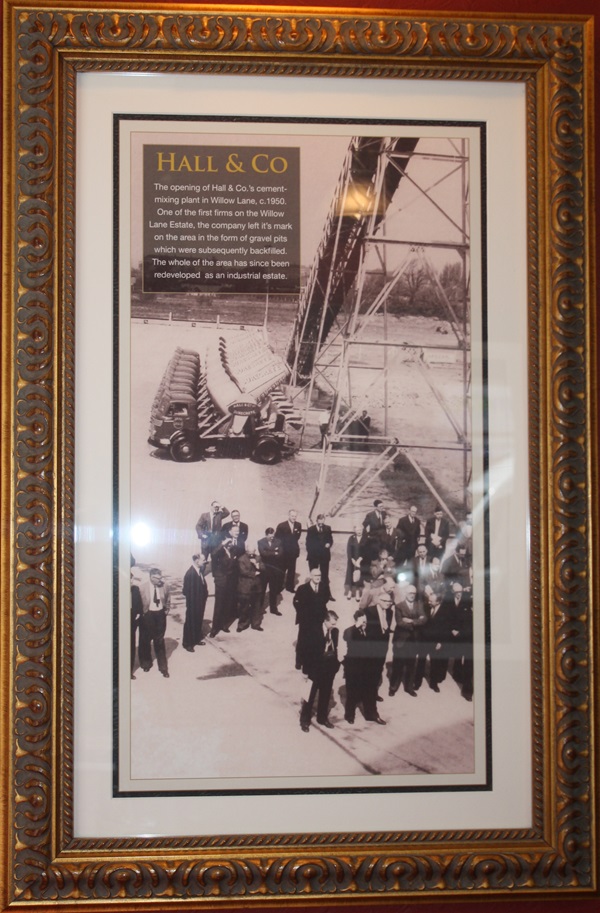
The text reads: The opening of Hall & Co.’s cement-mixing plant in Willow Lane, c1950. One of the first firms on the Willow Lane Estate, the company left its mark on the area in the form of gravel pits which were subsequently backfilled. The whole of the area has since been redeveloped as an industrial estate.
Photographs and text about Mitcham Police.
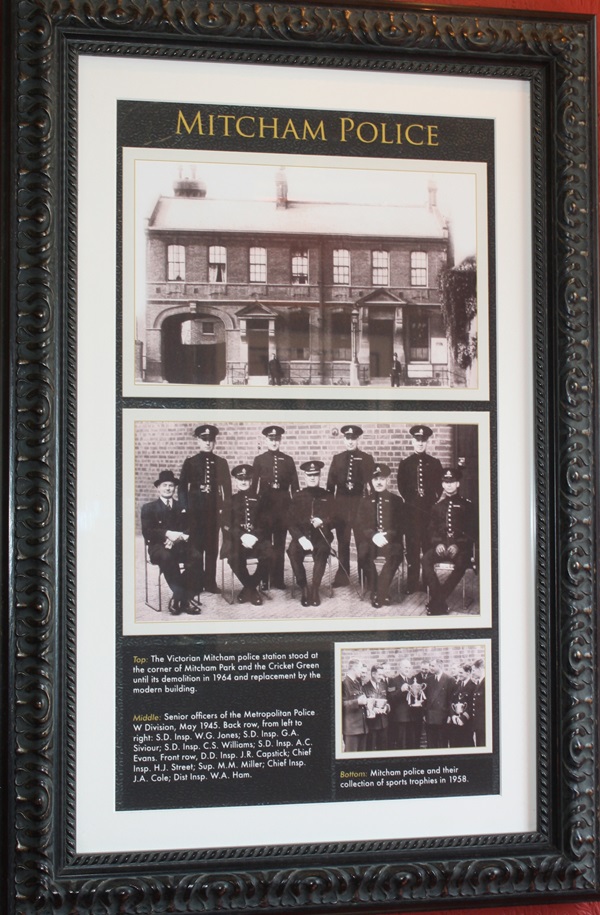
The text reads: Top: The Victorian Mitcham police station stood at the corner of Mitcham Park and the Cricket Green until its demolition in 1964 and replacement by the modern building.
Middle: Senior officers of the Metropolitan Police W Division, May 1945. Back row, from left to right: SD Insp. WG Jones; SD Insp. GA Sovopur; SD Insp. CS. Williams; SD Insp. AC Evans. Front row, DD Insp JR Capstick; Chief Insp. HJ Street; Sup. MM Miller; Chief Insp. JA Cole; Dist Insp. WA Ham.
Bottom: Mitcham police and their collection of sports trophies in 1958.
Photographs and text about the Mitcham town guard.
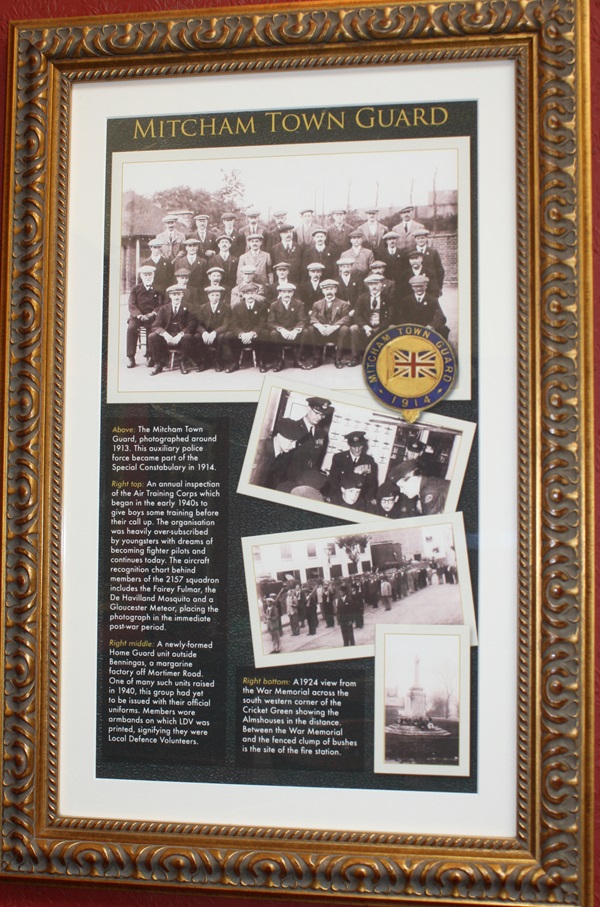
The text reads: Above: The Mitcham Town Guard, photographed around 1913. This auxiliary police force became part of the Special Constabulary in 1914.
Right top: An annual inspection of the Air Training Corps which began in the early 1940s to give boys some training before their call up. The organisation was heavily over-subscribed by youngsters with dreams of becoming fighter pilots and continues today. The aircraft recognition chart behind members of the 2157 squadron includes the Fairey Fulmar, the De Havilland Mosquito and a Gloucester Meteor, placing the photograph in the immediate post-war period.
Right middle: A newly formed Home Guard unit outside Benningas, a margarine factory off Mortimer Road. One of many such units raised in 1940, this group had yet to be issued with their official uniforms. Members wore armbands on which LDV was printed, signifying they were Local Defence Volunteers.
Right bottom: A 1924 view from the War Memorial across the south western corner of the Cricket Green showing the Almshouses in the distance. Between the War Memorial and the fenced clump of bushes is the site of the fire station.
Photographs and text about Mitcham Leisure Centre.
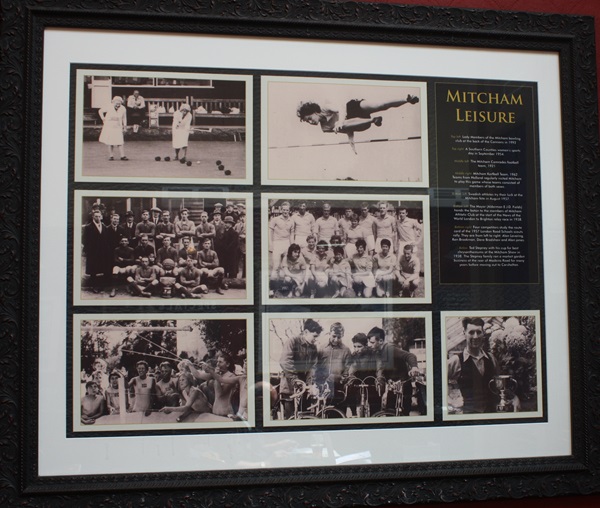
The text reads: Top left: Lady members of the Mitcham bowling club at the back of the cannons in 1992.
Top right: A southern counties women’s sports day in September 1954.
Middle left: The Mitcham Comrades football team, 1921.
Middle right: Mitcham Korfball Team, 1921. Teams from Holland regularly visited Mitcham to play this game whose teams consisted of members of both sexes.
Bottom left: Swedish athletes try their luck at the Mitcham fete in August 1957.
Bottom left: The Mayor (Alderman EJD Fields) hands the baton to the members of Mitcham Athletic Club at the start of the News of the World London to Brighton relay race in 1938.
Bottom right: Four competitors study the route card of the 1957 London Road Schools scouts rally. They are from left to right: Alan Lovering, Ken Brookman, Dave Bradshaw and Alan Jones.
Below: Ted Stepney with his cup for best chrysanthemums at the Mitcham Shaw in 1938. The Stepney family ran a market garden business at the rear of Madeira Road for many years before moving out to Carshalton.
Photographs and text about Mitcham events.
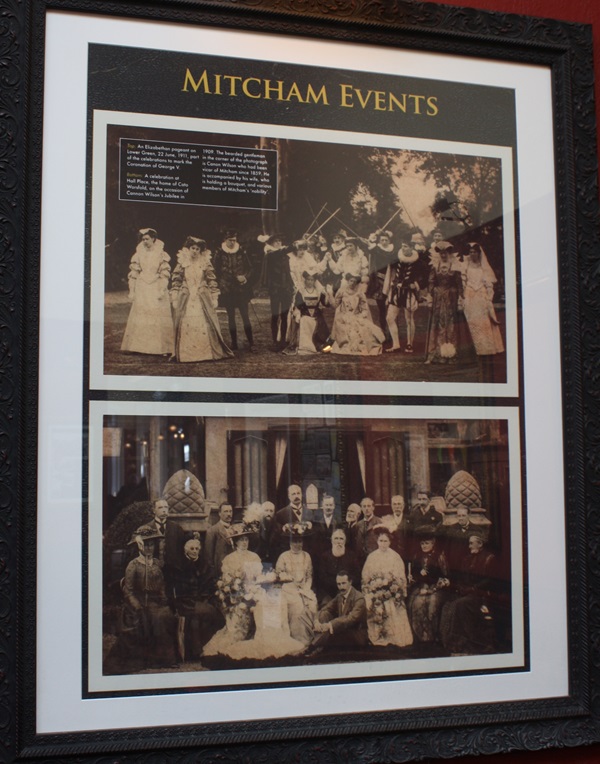
The text reads: Top: An Elizabethan pageant on Lower Green, 22 June, 1911, part of the celebrations to mark the Coronation of George V.
Bottom: A celebration at Hall Place, the home of Cato Worsfold, on the occasion of Cannon Wilson’s Jubilee in 1909. The bearded gentleman in the corner of the photograph is Canon Wilson who had been vicar of Mitcham since 1859. He is accompanied by his wife, who is holding a bouquet, and various members of Mitcham’s ‘nobility’.
Photographs and text about Mitcham events.
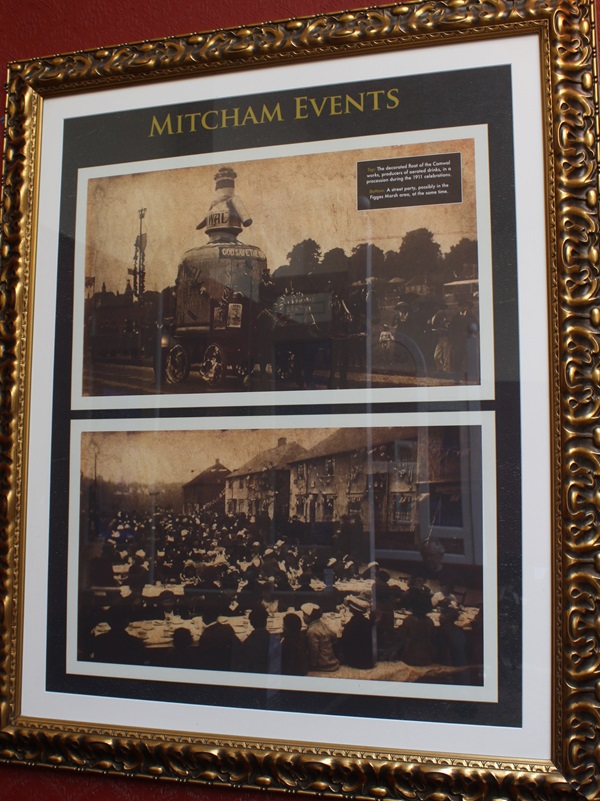
The text reads: Top: The decorated float of the Camwal works, producers of aerated drinks, in a procession during the 1911 celebrations.
Bottom: A street party, possibly in the Figges Marsh area, at the same time.
Photographs and text about the Blitz.
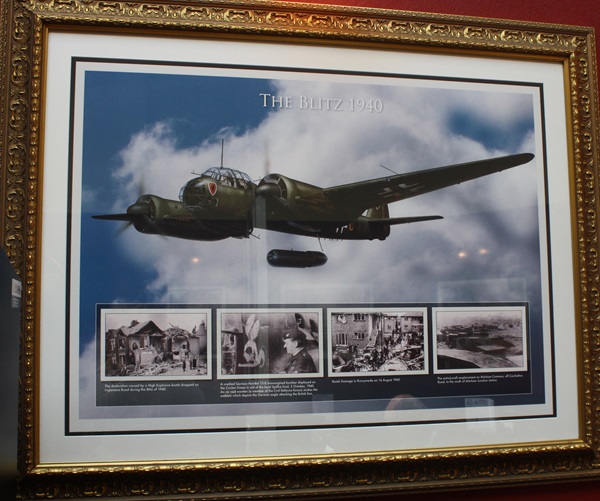
The text reads: The destruction caused by a High Explosive bomb dropped on Inglemere Road during the Blitz of 1940.
A crashed German Heinkel 111K twin-engined bomber displayed on the Cricket Green in aid of the local Spitfire fund, 2 October, 1940. An air raid warden (a member of the Civil Defence forces) studies the emblem which depicts the German eagle attacking the British lion.
Bomb damage in Runnymede on 14 August 1940.
The anti-aircraft emplacement on Mitcham Common, off Carshalton Road, to the south of Mitcham Junction station.
Photographs of a trolleybus at the Ravensbury Arms stop on the Common in 1958.
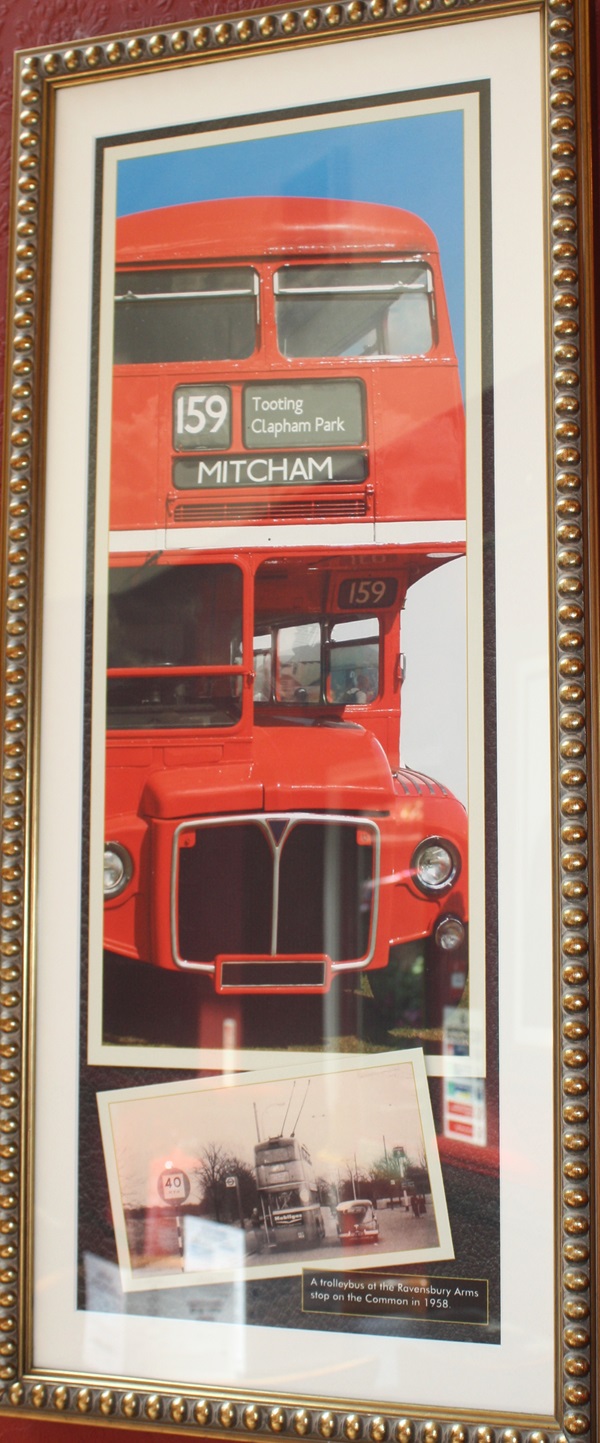
Photographs and text about Beddington Lane, Halt Station.
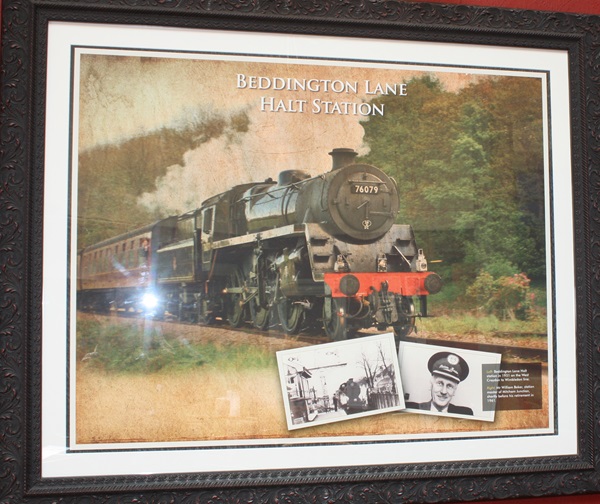
The text reads: Left: Beddington Lane Holt station in 1951 on the West Croydon to Wimbledon line.
Right: Mr William Baker, station master of Mitcham Junction, shortly before his retirement in 1961.
Photographs and text about Noel Fielding.
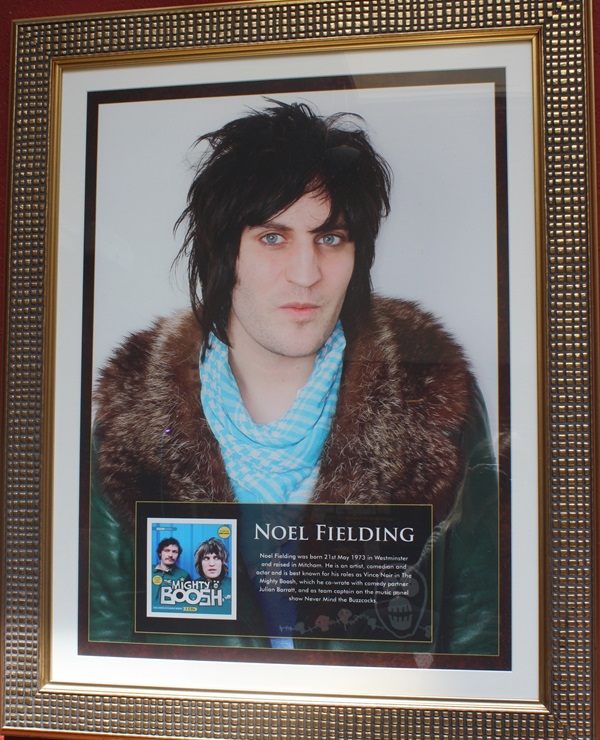
The text reads: Noel Fielding was born 21 May 1973 in Westminster and raised in Mitcham. He is an artist, comedian and actor and is best known for his roles as Vince Noir in The Mighty Boosh, which he co-wrote with his comedy partner Julian Barratt, and as team captain on the music panel show Never Mind the Buzzcocks.
A photograph and text about M.I.A.
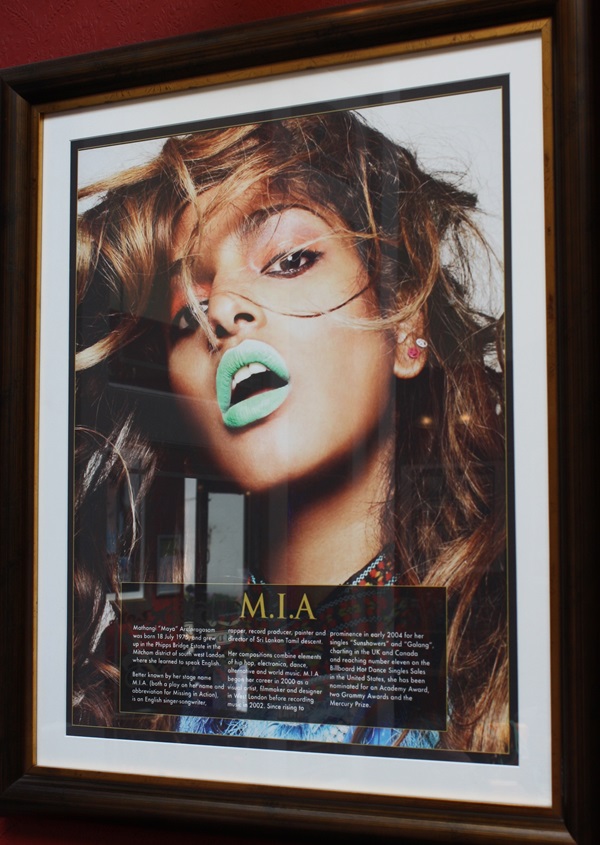
The text reads: Mathangi “Maya” Arulpragasam was born 18 July 1975, and grew up in Phipps Bridge Estate in the Mitcham district of south west London where she learned to speak English.
Better known by her stage name M.I.A. (both a play on her name and abbreviation for Missing in Action), is an English singer-songwriter, rapper, record producer, painter and director of Sri Lankan Tamil descent.
Her compositions combine elements of hip hop, electronica, dance, alternative and world music. M.I.A. began her career in 2000 as a visual artist, filmmaker and designer in West London before recording music in 2002. Since rising to prominence in early 2004 for her singles “Sunshowers” and “Galang”, charting in the UK and Canada and reaching number eleven on the Billboard Hot Dance Singles Sales in the United States, she has been nominated for an Academy Award, two Grammy Awards and Mercury Prize.
A photograph and text about Slick Rick.
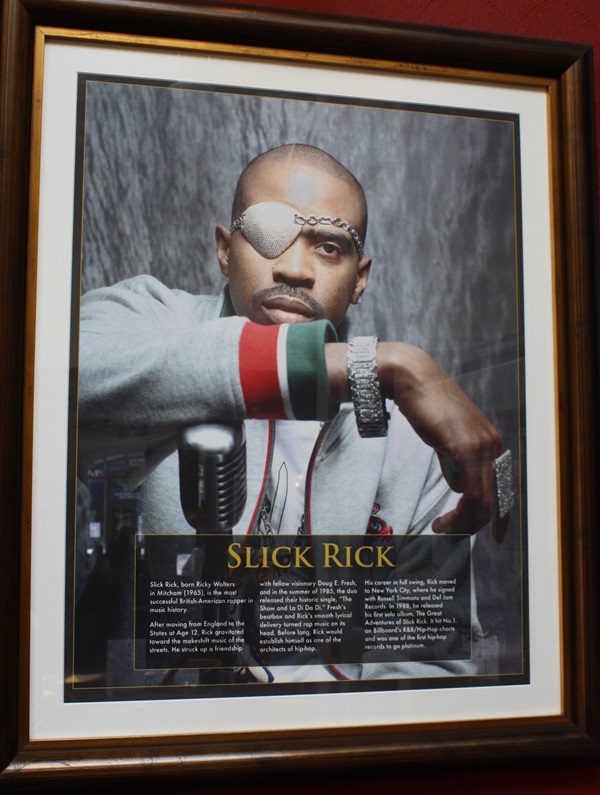
The text reads: Slick Rick, born Ricky Walters in Mitcham (1965), is the most successful British-American rapper in music history.
After moving from England to the States at Age 12, Rick gravitated toward the makeshift music of the streets. He struck up a friendship with fellow visionary Doug E Fresh, and in the summer of 1985, the duo released their historic single, “The Show and La Di Da Di”. Fresh’s beatbox and Rick’s smooth lyrical delivery turned rap music on its head. Before long, Rick would establish himself as one of the architects of hip-hop.
His career in full swing, Rick moved to New York City, where he signed with Russell Simmons and Def Jam Records. In 1988, he released his first solo album, The Great Adventures of Slick Rick. It hit No.1 on Billboard’s R&B/Hip-Hop charts and was one of the first hip-hop records to go platinum.
External photograph of the building – main entrance.
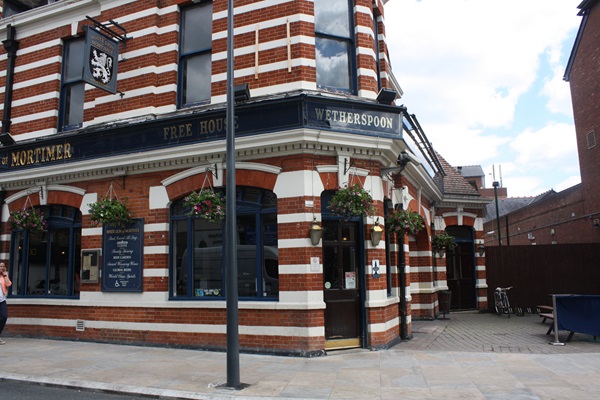
If you have information on the history of this pub, then we’d like you to share it with us. Please e-mail all information to: pubhistories@jdwetherspoon.co.uk